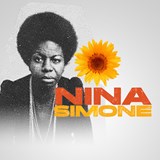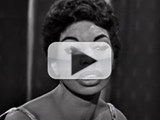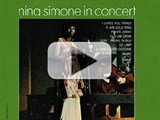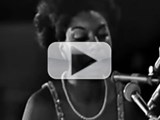By Brian Robin
Who Was Nina Simone?
The giant shadow of influence she cast on singers in the last quarter of the 20th century and the first 20 years of the 21st belie the fact that Nina Simone was one of the most underrated and underappreciated singers of her time.
She never got the attention her prime musical influence, Billie Holiday, received. Nor did she enjoy the accolades garnered by many of those calling her an influence in their music.
Artists such as Aretha Franklin, who re-recorded one of her civil rights anthems: “To Be Young, Gifted and Black,” thus cementing a musical bond between the “Queen of Soul” and the “High Priestess of Soul.”
Artists such as John Legend, who paid tribute to her during a performance at the 2015 Sundance Film Festival. There was Patti LaBelle, who credited Simone with making her more assertive in her career. She joined Simone, Elton John, James Taylor and Wynonna Judd at Sting’s 12th Annual Rainforest Foundation Concert in 2000. LaBelle would later sing at Simone’s 2003 memorial service in Harlem.
Artists such as John Lennon, who used Simone as an inspiration for The Beatles’ “Michelle” after Paul McCartney got stuck writing a portion of the song. Lennon told him he had been listening to Simone “who did something like ‘I love you!’ in one of her songs and that made me think of the middle eight for ‘Michelle.’”
Artists such as the late Jeff Buckley, who said on “The Jeff Buckley FAQ” that the only version of the popular song “Lilac Wine” he heard was Simone’s. “That’s the only one that matters. There’s one by Eartha Kitt. There’s one by Elkie Brooks, which I’ve never ever heard. There’s another one. But Nina does it best. That’s the end all of it. That’s the be-all, end-all version. She’s the king.”
Then, there was Mary J. Blige, who told Rolling Stone that “I heard her sing a song in French—I didn’t even know what she was saying, and I started crying. Then she goes from that to ‘Mississippi Goddam,’ singing it like a church record, but she’s cursing out the system. Nina could sing anything, period.”
So who was Nina Simone, besides the title character in SCR’s 2022-23 season-opening play Nina Simone:Four Women? The play set to Simone’s music runs Oct. 2-23 on the Julianne Argyros Stage.
How did this preacher’s daughter from small-town North Carolina become a powerful voice for the silent? How did the underappreciated and oft-misunderstood Simone become the influence for a roster of musicians worthy of their own wing in the Rock and Roll Hall of Fame? How did someone who missed her calling as a classical pianist earn the No. 29 ranking on Rolling Stone’s 100 Greatest Singers in Music History?
Born Eunice Kathleen Waymon on February 21, 1933, Simone displayed a Mozart-esque prodigal talent, playing piano by ear by the time she was 3. She was playing Bach, Chopin, Brahms, Beethoven and Schubert by her early teens.
After graduating from Juilliard, where she aspired to be a classical pianist, Waymon was rejected by the prestigious Curtis Institute of Music in Philadelphia.
This turned out to be one of those turning points in life. In 1954, looking to supplement her income teaching music, Waymon auditioned for a piano gig at the Midtown Bar & Grill in Atlantic City. She not only landed the gig, but was told she’d sing as well.
And thus Nina Simone was born. The name change came about because Waymon wanted to hide the fact she was singing in bars from her Methodist preacher mother. She took the name “Nina” meaning “little one” in Spanish, pairing it with Simone after the actress Simone Signoret.
In the meantime, the newly named Simone and her velvety-smooth voice were mixing George Gershwin, Cole Porter, Richard Rodgers and classical lions like Beethoven and Bach into a rich gumbo of jazz, blues and classical music. Word of mouth spread up and down the Eastern Seaboard about this prodigy, leading to her first record contract with Bethlehem Records.
This led to Simone borrowing from her influence, Holiday. She recorded “I Loves You, Porgy” and “My Baby Just Cares For Me,” previously covered by Nat King Cole, Count Basie and Woody Herman. Three decades later, Chanel would use that in its European advertising campaign and the song would become a huge hit for Simone. Later, Usher would perform “My Baby” at Nina Revisited: A Tribute to Nina Simone.
After moving to Colpix Records in 1959, Simone’s career took off. She became known as a must-see live performer, playing the 1960 Newport Jazz Festival, one of the most prestigious jazz concerts in the nation. Her version of “Trouble In Mind” recorded at Newport gave Simone her third charted single.
She recorded nine albums for Colpix, but Simone’s versatility defied the musical convention of the 1950s and early 1960s. Critics twisted themselves into pretzels trying to define the undefinable Simone. How could you pigeon-hole someone talented enough to cross over all genres seamlessly?
“Critics started to talk about what sort of music I was playing and tried to find a neat slot to file it away in,” she wrote in her 1991 autobiography, I Put A Spell On You. “It was difficult for them because I was playing popular songs in a classical style with a classical piano technique influenced by cocktail jazz. On top of that, I included spirituals and children’s sings in my performances, and those sorts of songs were automatically identified with the folk movement. So, playing what sort of music I played gave the critics problems because there was something from everything in there. But it also meant I was appreciated across the board—by jazz, folk, pop and blues fans as well.”
Coming into the 1960s, one of the most musically diverse decades of the 20th century, Simone would have thrived. Her electric live performances endeared her to fans across the music spectrum and it’s not inconceivable to see her performing at such iconic venues as the Monterey Jazz Festival or even Woodstock.
But three life-changing elements that played a role in Nina Simone: Four Women sent her in another direction. The first: befriending noted playwright Lorraine Hansberry. The two spent countless hours discussing the burgeoning Civil Rights Movement and Hansberry became a personal muse of sorts to Simone.
The second: the June 1963 killing of activist Medgar Evers in the driveway of his Mississippi home. And the bombing of the 16th Street Baptist Church in Birmingham in September 1963 completed the career-changing trifecta.
Not that it was easy. Not that this was a natural leap of faith. It was anything but. On her first album for her new label, Philips, Simone went all-in.
“Nightclubs were dirty, making records was dirty, popular music was dirty and to mix all that with politics seemed senseless and demeaning,” she wrote in I Put A Spell On You. “And until songs like ‘Mississippi Goddam’ just burst out of me, I had musical problems as well. How can you take the memory of a man like Medgar Evers and reduce all that he was to three and a half minutes and a simple tune?
“That was the musical side of it I shied away from; I didn’t like ‘protest music’ because a lot of it was so simple and unimaginative. It stripped the dignity away from the people it was trying to celebrate. But the Alabama church bombing and the murder of Medgar Evers stopped that argument and with ‘Mississippi Goddam,” I realized there was no turning back.”
There wasn’t. Southern radio stations refused to play the song. A North Carolina radio station smashed promotional copies and sent the pieces back to Philips. Unapologetic, Simone said the song was “like throwing ten bullets back at them.” She had reached the end of her proverbial rope and the time to use her powerful voice for more than entertainment had arrived.
Simone later honored her late friend Hansberry by turning the title of her play To Be Young, Gifted and Black into an anthem of empowerment. Mississippi Goddam unleashed a creative fury, resulting in other songs such as Old Jim Crow, Backlash Blues and Turning Point, which became go-to choruses for civil rights.
None of this dulled Simone’s in-person incandescence. In October 1969, she played to a sold-out audience at Philharmonic Hall in New York. The Grammy-nominated live album that came out of that, BlackGold, reminded her audience in searing color that civil rights remained as elusive as racism was pervasive.
As the 1970s began, so did Simone’s wanderlust. She spent that decade and the early 1980s moving from Liberia to Barbados to England to Belgium, to France, to Switzerland and finally the Netherlands. She recorded for various labels, highlighted by 1978’s critically acclaimed Baltimore, the title track coming from a Randy Newman song. Simone hated the album and said she had no creative control. True to form, Baltimore showcased Simone’s eclectic versatility, featuring everything from spirituals to Rich Girl, which Hall & Oates would put on the U.S. rock charts several years later.
In 1993, with two marriages in the rear-view mirror, Simone landed in Carry-le-Rout in southern France. Battling what was diagnosed as bipolar disorder—which caused her to lash out angrily at slights real or imagined—Simone recorded her last album, A Single Woman that year. She played her last concert in the U.S. in 1998, telling a Newark, N.J. audience “If you’re going to come see me again, you’ve got to come to France, because I am not coming back.”
She didn’t. Simone died in her sleep on April 21, 2003 of complications from breast cancer. She left a legacy that included four Grammy nominations, induction into the Rock and Roll Hall of Fame (2018)—where Mary J. Blige gave the induction speech—and induction into the Rhythm & Blues Hall of Fame in 2021. It also included numerous books and films about her and her life.
In 2019, the Library of Congress paid long-overdue homage to Simone’s personal mantra that “An artist’s responsibility is to reflect the times.” It selected Mississippi Goddam for preservation in the National Recording Registry. It called the work “culturally, historically, or aesthetically significant.”
Given what led to Simone writing it, that is an appropriate trifecta.
Which takes us full circle to Simone’s recognizable influence, which outlives her. Her influence on artists from Aretha to Jay-Z is so pronounced that Aretha won one of her Grammys covering Simone’s To Be Young, Gifted and Black, and Jay-Z included a sample of Four Women on his Grammy-nominated “The Story of O.J.”
Then, there’s Elton John, who named one of his pianos after Simone. But one of the best tributes to Simone came not from a singer, but from a comedic pioneer.
“White people had Judy Garland,” Richard Pryor was quoted in Rolling Stone. “We had Nina.”







